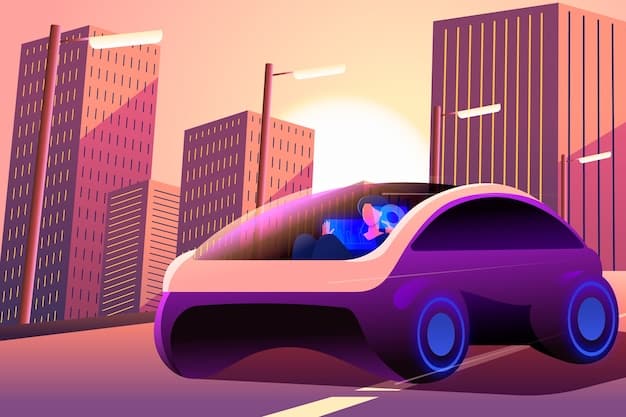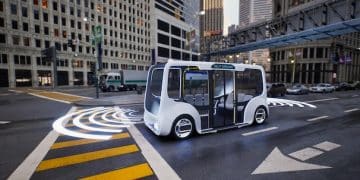Autonomous Vehicle Testing in US Cities: A 2025 Regulatory Update

Understanding the Impact of New Federal Regulations on Autonomous Vehicle Testing in US Urban Areas: A 2025 Update reveals significant shifts in safety standards, operational constraints, and technological adaptations that stakeholders must navigate to ensure responsible deployment and public acceptance.
The landscape of autonomous vehicle (AV) testing in the United States is poised for a significant transformation. Understanding the Impact of New Federal Regulations on Autonomous Vehicle Testing in US Urban Areas: A 2025 Update is crucial for manufacturers, tech companies, and city planners aiming to navigate the evolving regulatory environment.
Navigating the New Federal Regulations for AV Testing
The rise of autonomous vehicles promises to revolutionize urban mobility, offering potential benefits like reduced congestion, improved safety, and increased accessibility. However, this technological leap requires a robust regulatory framework to ensure public safety and manage the risks associated with AV deployment. New federal regulations are set to significantly impact how autonomous vehicles are tested and operated in US urban areas by 2025.
These regulations address key aspects such as safety standards, data collection and privacy, cybersecurity, and operational guidelines. To fully grasp the implications, it’s crucial to delve into the specifics of these regulations and how they will shape the future of AV testing and deployment.
Key Areas of Regulation
- Safety Performance Standards: Setting specific performance requirements for AVs to ensure they meet or exceed current safety benchmarks for human-driven vehicles.
- Data Recording and Sharing: Mandating the collection and sharing of data related to AV performance, incidents, and near-misses to improve safety and inform future regulations.
- Cybersecurity Requirements: Establishing protocols to protect AV systems from cyber threats and ensure the integrity of their operations.
- Operational Design Domain (ODD) Limitations: Defining the specific conditions under which AVs are permitted to operate, such as weather, road type, and time of day.
Understanding these key areas is essential for stakeholders to comply with the new federal regulations and contribute to the safe and responsible deployment of autonomous vehicles in US urban areas. The collaborative effort of regulatory bodies, industry leaders, and researchers will ultimately define the future of urban mobility.

Enhanced Safety Standards for Autonomous Vehicles
Safety is paramount in the development and deployment of autonomous vehicles. The new federal regulations introduce enhanced safety standards to mitigate risks and build public trust in AV technology. These standards cover a wide range of aspects, from vehicle design and functionality to testing protocols and emergency response procedures.
Compliance with these standards requires rigorous testing, validation, and certification processes. Manufacturers must demonstrate that their AVs can operate safely under various conditions and respond effectively to unexpected events. The emphasis on safety reflects the commitment to protecting people and property while harnessing the potential benefits of autonomous vehicles.
Impact on Testing Procedures
The enhanced safety standards will necessitate more comprehensive and realistic testing scenarios. This may include:
- Simulated Environments: Using advanced simulation tools to replicate complex urban environments and challenging driving conditions.
- Closed-Course Testing: Conducting extensive testing on dedicated test tracks to evaluate AV performance in controlled settings.
- Real-World Testing: Deploying AVs in limited urban areas under strict supervision to gather data and refine algorithms.
By adhering to these enhanced safety standards and implementing rigorous testing procedures, the AV industry can demonstrate its commitment to safety and accelerate the adoption of autonomous vehicles in US urban areas.
Operational Constraints and Urban Deployment
The deployment of autonomous vehicles in urban environments presents unique challenges due to the complexity of city streets, pedestrian traffic, and unpredictable events. The new federal regulations address these challenges by imposing operational constraints on AV testing and deployment. These constraints aim to minimize risks and ensure that AVs operate safely within designated operational design domains (ODDs).
ODDs specify the conditions under which AVs are permitted to operate, such as weather, road type, time of day, and traffic density. By limiting AV operation to specific ODDs, regulators can manage the risks associated with deploying AVs in complex urban environments. This phased approach allows for gradual expansion as AV technology improves and safety data accumulates.
Examples of Operational Constraints
- Geofencing: Restricting AV operation to specific geographic areas within a city.
- Speed Limits: Imposing maximum speed limits for AVs operating in urban areas.
- Weather Restrictions: Prohibiting AV operation during adverse weather conditions such as heavy rain, snow, or fog.
These operational constraints are designed to balance the potential benefits of AV technology with the need to protect public safety. By carefully managing the deployment of AVs in urban environments, regulators can ensure that these vehicles operate safely and responsibly.

Technological Adaptations and Innovation
The new federal regulations are driving significant technological adaptations and innovation in the autonomous vehicle industry. To comply with the enhanced safety standards and operational constraints, AV developers are investing in advanced sensor technologies, artificial intelligence algorithms, and redundant safety systems. These innovations are crucial for ensuring the safe and reliable operation of AVs in complex urban environments.
One key area of technological adaptation is the development of more robust and resilient sensor systems. AVs rely on a combination of cameras, radar, and lidar to perceive their surroundings and make informed decisions. Improving the accuracy and reliability of these sensors is essential for enabling AVs to operate safely in challenging conditions.
Areas of Innovation
- Sensor Fusion: Combining data from multiple sensors to create a more complete and accurate representation of the environment.
- AI-Powered Decision-Making: Developing sophisticated AI algorithms that can anticipate and respond to unexpected events in real-time.
- Redundant Safety Systems: Implementing backup systems for critical functions such as steering, braking, and power to ensure continued operation in the event of a failure.
These technological adaptations are not only enabling AVs to meet the new federal regulations but also driving innovation across the broader transportation industry. The advancements in sensor technology, AI, and safety systems are paving the way for safer, more efficient, and more sustainable urban mobility solutions.
The Role of Data Collection and Privacy
Data collection plays a critical role in the development, testing, and deployment of autonomous vehicles. AVs generate vast amounts of data related to their performance, behavior, and interactions with the environment. This data is used to improve AV algorithms, validate safety, and inform regulatory decisions. However, the collection and use of AV data also raise important privacy concerns that must be addressed.
The new federal regulations include provisions to protect the privacy of individuals while allowing for the collection of data necessary for AV development and safety. These provisions typically involve anonymizing data, limiting data retention periods, and ensuring transparency about data collection practices. Striking the right balance between data utility and privacy protection is essential for fostering public trust and enabling the responsible deployment of AV technology.
Key Considerations for Data Privacy
Stakeholders must consider the following when dealing with AV data:
- Data Minimization: Collecting only the data that is necessary for a specific purpose.
- Data Anonymization: Removing personally identifiable information from data sets.
- Data Security: Protecting data from unauthorized access or use.
- Transparency: Communicating clearly about data collection and use practices.
By adhering to these principles, the AV industry can demonstrate its commitment to protecting privacy and ensuring that AV data is used responsibly.
Stakeholder Collaboration and Public Acceptance
The successful deployment of autonomous vehicles in US urban areas requires close collaboration among a wide range of stakeholders, including federal regulators, state and local governments, AV manufacturers, technology companies, researchers, and the public. Building public trust and acceptance is essential for realizing the potential benefits of AV technology. This involves addressing public concerns about safety, security, and privacy, and involving the public in the decision-making process.
Effective communication and outreach efforts can help to educate the public about AV technology, its potential benefits, and the measures being taken to ensure safety. Public demonstrations and pilot programs can provide opportunities for people to experience AVs firsthand and ask questions. By fostering open dialogue and collaboration, stakeholders can build a shared understanding of the opportunities and challenges associated with AV deployment and work together to create a future of urban mobility that is safe, sustainable, and accessible to all.
| Key Point | Brief Description |
|---|---|
| 🚦 New Regulations | Federal rules impacting AV testing in US cities by 2025. |
| 🛡️ Safety Standards | Enhanced safety requirements for AV design and operation. |
| 📍 Operational Limits | Restrictions on where and how AVs can operate in cities. |
| 🔒 Data Privacy | Rules to protect personal data collected by autonomous vehicles. |
Frequently Asked Questions
▼
The primary goals include enhancing safety, establishing clear operational guidelines, and protecting data privacy related to autonomous vehicle testing and deployment in urban areas.
▼
While potentially slowing down initial deployment, the regulations aim to ensure long-term sustainable growth by building public trust and ensuring robust safety standards.
▼
AVs collect data on vehicle performance, driving patterns, environmental conditions, and interactions with other vehicles and pedestrians. These datasets are used for validation.
▼
Cities are conducting pilot programs, upgrading infrastructure, and engaging with stakeholders to develop policies that integrate AVs safely and efficiently into their transportation networks.
▼
Potential benefits include reduced traffic congestion, fewer accidents, enhanced mobility for elderly/disabled, and more sustainable transportation solutions through optimized routes.
Conclusion
Understanding the Impact of New Federal Regulations on Autonomous Vehicle Testing in US Urban Areas: A 2025 Update is paramount for stakeholders seeking to shape the future of urban mobility. With safety, innovation, and collaboration at the forefront, the AV industry can navigate these changes and drive progress towards a safer, more efficient, and sustainable transportation ecosystem.





